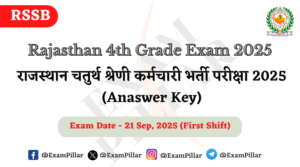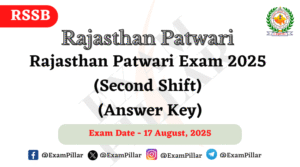101. निम्न में से कौन सा युग्म सही है
. संस्थान – स्थापना
(A) राजस्थान हिन्दी ग्रन्थ अकादमी – 1980
(B) राजस्थान साहित्य अकादमी – 1969
(C) राजस्थान संगीत नाटक अकादमी – 1957
(D) राजस्थान ब्रज भाषा अकादमी – 1982
Show Answer/Hide
102. ‘अशोकाष्टमी’ मनाई जाती है
(A) चैत्र शुक्ल अष्टमी को
(B) चैत्र कृष्ण अष्टमी को
(C) वैशाख शुक्ल अष्टमी को
(D) श्रावण कृष्ण अष्टमी को
Show Answer/Hide
103. राजस्थान राज्य के प्रथम मुख्य सूचना आयुक्त कौन थे ?
(A) श्री इन्द्रजीत खन्ना
(B) श्री एन.के. जैन
(C) श्री अमरजीत सिंह
(D) श्री एम.डी. कौराणी
Show Answer/Hide
104. राजस्थान राज्य मानवाधिकार आयोग के अध्यक्ष और सदस्यों की नियुक्ति एक उच्च स्तरीय समिति की संस्तुति पर राज्यपाल द्वारा की जाती है। इस समिति के अध्यक्ष होते हैं:
(A) उच्च न्यायालय के मुख्य न्यायाधीश
(B) मुख्यमंत्री
(C) राज्य विधान मण्डल के अध्यक्ष
(D) सर्वोच्च न्यायालय के मुख्य न्यायाधीश
Show Answer/Hide
105. नीति निर्माण एक संयुक्त प्रयास होता है जिसमें बहुत सी संस्थाएँ हिस्सा लेती हैं। उन्हें सुमेलित करें:
a. संविधान – 1. नीति निर्माण में महत्त्वपूर्ण भूमिका
b. संसद – 2. नीति निर्माण के लिए मुख्य निकाय
c. मंत्रिमंडल – 3. नीतियों का मुख्य स्रोत भारतीय संविधान है । प्रस्तावना और निदेशक सिद्धांत उसके प्रेरणा स्रोत हैं।
d. नीति आयोग – 4. सरकार की मुख्य संसद द्वारा अनुमोदित की जाती हैं।
कूट :
. a b c d
(A) 1 4 3 2
(B) 3 4 2 1
(C) 3 2 1 4
(D) 2 1 3 4
Show Answer/Hide
106. किस विकल्प में विलोम युग्म है ?
(A) द्रुत – मंद
(B) खोट – खौफ
(C) तीर्थ – तीखा
(D) मरियल – मरीचि
Show Answer/Hide
107. ‘दूध के दाँत न टूटना’ मुहावरे का अर्थ है:
(A) अस्थाई होना
(B) ज्ञान और अनुभव न होना
(C) उम्र सात वर्ष से कम होना
(D) कमजोर होना
Show Answer/Hide
108. निम्न में से किस शब्द का संधि-विच्छेद सही नहीं है
(A) षडानन = षट् + आनन
(B) गुरुपदेश= गुरु + उपदेश
(C) सप्तर्षि = सप्त + ऋषि
(D) अत्यावश्यक = अती + आवश्यक
Show Answer/Hide
109. निम्न में से किस विकल्प के सभी शब्दों में उपसर्ग तथा प्रत्यय (दोनों) का प्रयोग हुआ है ?
(A) सुबासिक, अभिमानी
(B) उनतीस, वर्तमान
(C) भुलक्कड़, हँसोड़ा
(D) फिलहाल, अधकचरा
Show Answer/Hide
110. ‘रेलभाड़ा’ शब्द किस समास का उदाहरण है ?
(A) बहुव्रीहि समास
(B) अव्ययीभाव समास
(C) तत्पुरुष समास
(D) कर्मधारय समास
Show Answer/Hide
111. किस विकल्प में शब्द-युग्म का अर्थ-भेद सही नहीं है ?
. शब्द-युग्म – अर्थ-भेद
(A) पवन पावन वायु – पवित्र
(B) गृह ग्राह घर – घड़ियाल
(C) आकार आकर आकृति – रचना
(D) परिमाण परिणाम मात्रा – नतीजा
Show Answer/Hide
112. निम्नलिखित शब्दों पर विचार कीजिए:
(1) साम्प्रदायिक
(2) न्यायाधीश
(3) पारीश्रमिक
(4) अभिसेक
किस विकल्प में सभी शब्द शुद्ध हैं ?
(A) (1) (2) और (4)
(B) (1) और (4)
(C) (2) और (3)
(D) (1) और (2)
Show Answer/Hide
113. व्याकरण की दृष्टि से निम्न में से कौन सा शुद्ध हैं ?
(A) आज मुझे बाजार जाना है।
(B) सूर्य पूर्व पर उगता है।
(C) राम रोटी खाया।
(D) मैंने भगवद्गीता पढ़ा है।
Show Answer/Hide
114. किस वाक्यांश के लिए प्रयुक्त शब्द सार्थक नहीं है।
(A) हिंसा करने वाला हिंसक
(B) पति धर्म ही जिसका व्रत हो पतिव्रता
(C) शोक की शुरुआत शोकांत
(D) सुंदर आकार वाला- सुडौल
Show Answer/Hide
115. किस विकल्प में अंग्रेजी पारिभाषिक शब्द का समकक्ष हिन्दी पारिभाषिक शब्द सही है ?
(A) Review – पुनर्विलोकन
(B) Enforcement – अप्रभावशील होना
(C) Maladministration – व्यवस्थित प्रशासन
(D) Overdraft – अतिमात्रा
Show Answer/Hide
116. किस विकल्प में ‘Indorsement’ शब्द का समकक्ष हिन्दी पारिभाषिक शब्द सही है ?
(A) अधिरोपण
(B) अविश्वसनीय
(C) आक्षेप
(D) पृष्ठांकन
Show Answer/Hide
117. किस विकल्प में सभी शब्द परस्पर पर्यायवाची नहीं है।
(A) मोक्ष, कैवल्य, मुक्त
(B) राधा, कमला, हरिप्रिया
(C) वस्त्र, वसन, पट
(D) लहर, तरंग, हिलोर
Show Answer/Hide
Comprehension
Directions: Read the following passage carefully and answer the questions given below: (118 to 122)
Philosophy of Education is a label applied to the study of the purpose, process, nature and ideals of education. It can be considered a branch of both philosophy and education. Education can be defined as the teaching and learning of specific skills, and the imparting of knowledge, judgment and wisdom, and is something broader than the societal institution of education we often speak of.
Many educationalists consider it a weak and woolly field, too far removed from the practical applications of the real world to be useful. But philosophers dating back to Plato and the Ancient Greeks have given the area much thought and emphasis, and there is little doubt that their work has helped shape the practice of education over the millennia.
Plato is the earliest important educational thinker, and education is an essential element in “The Republic” (his most important work on philosophy and political theory, written around 360 B.C.). In it, he advocates some rather extreme methods: removing children from their mothers’ care and raising them as wards of the and differentiating children suitable to the various castes, the highest receiving the most education, so that they could act as guardians of the city and care for the less able. He believed that education should be holistic, including facts, skills, physical discipline, music and art. Plato believed that talent and intelligence is not distributed genetically and thus is not found in children born to all classes, although his proposed system of selective public education for an educated minority of the population does not really follow a democratic model.
Aristotle considered human nature, habit and reason to be equally important forces to be cultivated in education, the ultimate aim of which should be to produce good and virtuous citizens. He proposed that teachers lead their students systematically, and that repetition be used as a key tool to develop good habits, unlike Socrates’ emphasis on questioning his listeners to bring out their own ideas. He emphasized the balancing of the theoretical and practical aspects of subjects taught, among which he explicitly mentions reading, writing, mathematics, music, physical education, literature, history, and a wide range of sciences, as well as play, which he also considered important During the Medieval period, the idea of Perennialism was first formulated by St. Thomas Aquinas in his work “De Magistro”. Perennialism holds that one should teach those things deemed to be of everlasting importance to all people everywhere, namely principles and reasoning, not just facts (which are apt to change over time), and that one should teach first about people, not machines or techniques. It was originally religious in nature, and it was only much later that a theory of secular perennialism developed.
During the Renaissance, the French skeptic Michel de Montaigne (1533-1592) was one of the first to critically look at education. Unusually for his time, Montaigne was willing to question the conventional wisdom of the period, calling into question the whole edifice of the educational system, and the implicit university-educated philosophers were necessarily wiser than uneducated farm workers, for example.
118. Why do educationists consider philosophy a ‘weak and woolly’ field ?
(A) None of these
(B) It is not practically applicable.
(C) Its theoretical concepts are easily understood.
(D) It is irrelevant for education.
Show Answer/Hide
119. What do you understand by the term Perennialism’, in the context of the given comprehension passage ?
(A) It refers to something which existed in the past and no longer exists now.
(B) It refers to something which is of permanent importance.
(C) If refers to something which is quite unnecessary.
(D) It refers to something which is abstract and theoretical.
Show Answer/Hide
120. Were Plato’s beliefs about education democratic?
(A) None of these
(B) No, not at all.
(C) Yes, it was democratic completely.
(D) Yes, it was democratic partially.
Show Answer/Hide











